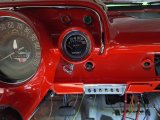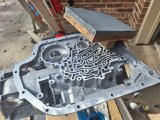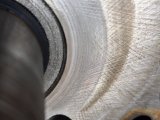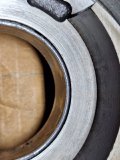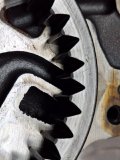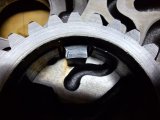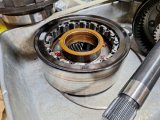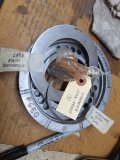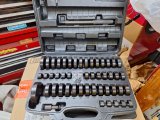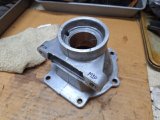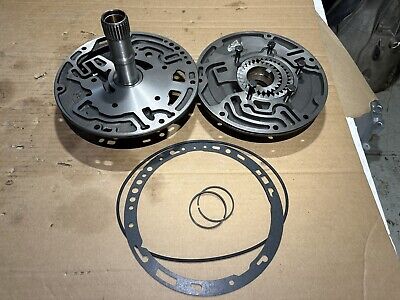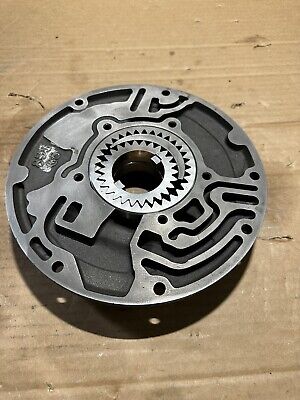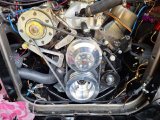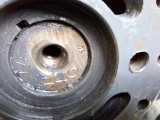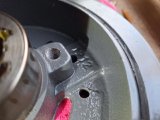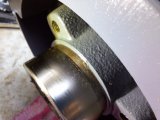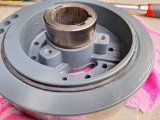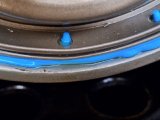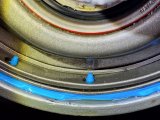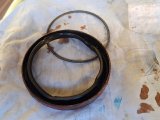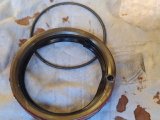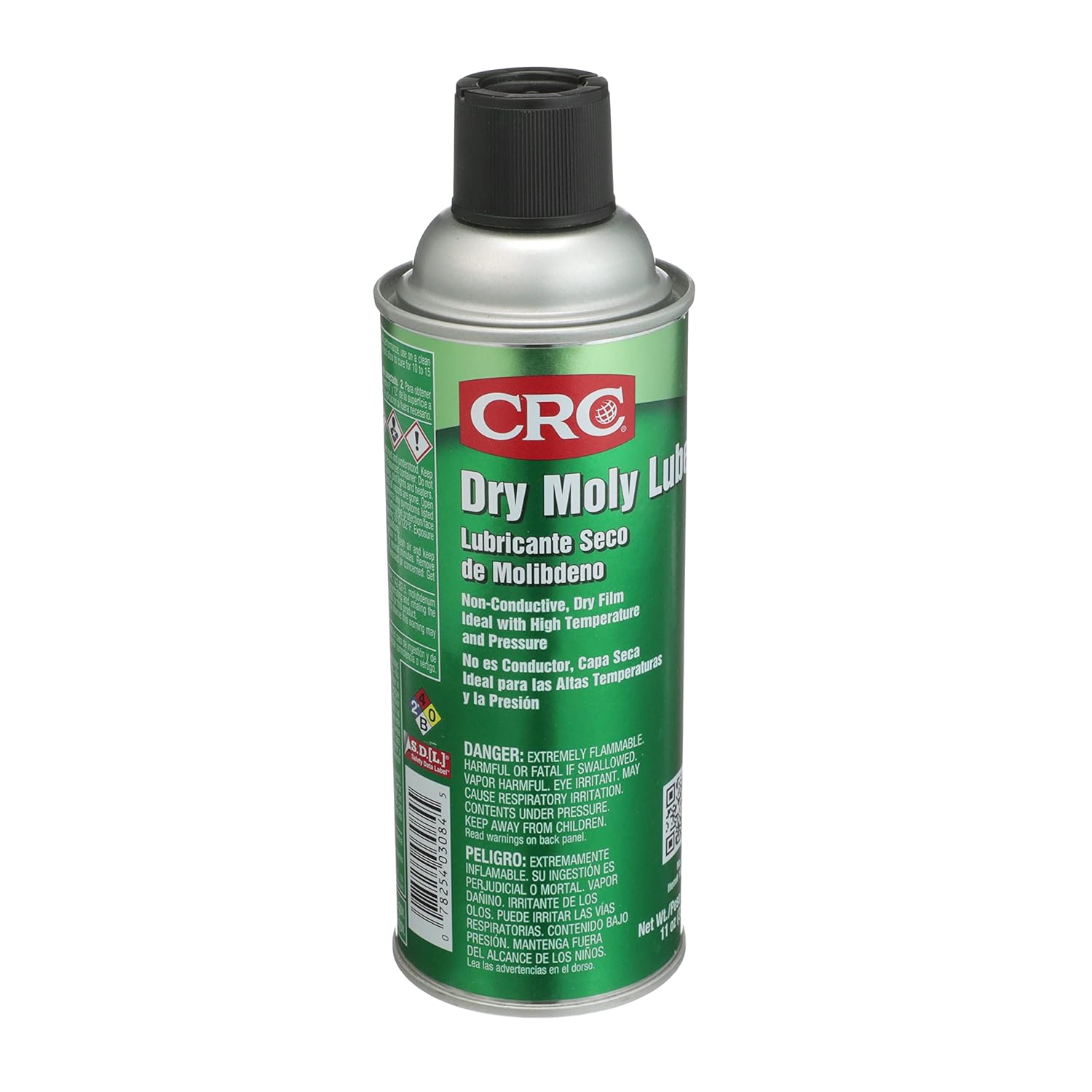Not happy - I found a small oil drip under the balancer. Looking closely, it appears to be at the balancer seal - the oil pan seal is dry.
New seal of course, installed carefully with the front cover off and lubed with transmission assembly lube until first engine start.
Here's what I'm thinking as a possibility...
The balancer had a very slight ring where the previous seal was riding. As a preemptive measure I installed an SKF sleeve on the balancer to provide a new surface. I used the install tool and sealant provided in the kit. I also applied a very light touch of permatex to the keyway slot.
If you look in the picture that sleeve doesn't go all the way to the front of the balancer. I had measured where the ring was vs the end of the sleeve. It was close but the new sleeve covered that ring. But now I'm wondering if for whatever reason it's too close and there's some oil seepage right at the edge of the seal. But as I recall the removable push ring on the sleeve went to the bottom of the balancer. By "bottom" I mean the forward face of the balancer. The balancer was removed and installed using the proper tools.
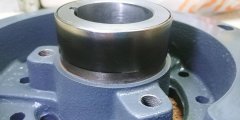
Maybe the new seal is at fault, or for some reason it sits in a slightly different location. The cover itself is a GM performance cover, thick steel and aligned ok. There's also a functional pcv system on the engine so I don't think its an internal pressure issue pushing oil out.
As always your advice is appreciated, but it looks like I need to pull the balancer and inspect shaft and seal. For sure I'll install a new seal and a new stock balancer isn't that much. I think I can do this with the radiator in the car but I'll have to measure to verify. At worse I'll have to pull the radiator, not that fun.
First I'll use my inspection camera to get a really close look underneath. There's a frame tab right under the balancer so I can't just eyeball it directly.
Thoughts?
Edit - after above post I put a piece of cardboard on the frame rail under the balancer. Today I looked at and its dry. I also used my camera and found no telltale drop and I think I can see that small section of non-sleeved balancer shaft, so it seems that the seal should be in the right place. But that oil drip under the car has to be coming from somewhere!
This is mystery drip #2, I'm still looking for the drop that accumulates at the oil filter rail, its not the filter. I trace upwards, especially at the valve cover and back of intake and cannot find the source. Very difficult to put baby powder back there with the engine in place. Feeling like an idiot at this point. I may add dye and see. Engine runs like a top. I know where the oil returns are on the head, if oil was seeping at the back of the head gasket for some reason, seems that there would be other tells as well?
Note - both of these oil leaks are a few drops over at least 24 hrs, not a quick immediate leak.
New seal of course, installed carefully with the front cover off and lubed with transmission assembly lube until first engine start.
Here's what I'm thinking as a possibility...
The balancer had a very slight ring where the previous seal was riding. As a preemptive measure I installed an SKF sleeve on the balancer to provide a new surface. I used the install tool and sealant provided in the kit. I also applied a very light touch of permatex to the keyway slot.
If you look in the picture that sleeve doesn't go all the way to the front of the balancer. I had measured where the ring was vs the end of the sleeve. It was close but the new sleeve covered that ring. But now I'm wondering if for whatever reason it's too close and there's some oil seepage right at the edge of the seal. But as I recall the removable push ring on the sleeve went to the bottom of the balancer. By "bottom" I mean the forward face of the balancer. The balancer was removed and installed using the proper tools.

Maybe the new seal is at fault, or for some reason it sits in a slightly different location. The cover itself is a GM performance cover, thick steel and aligned ok. There's also a functional pcv system on the engine so I don't think its an internal pressure issue pushing oil out.
As always your advice is appreciated, but it looks like I need to pull the balancer and inspect shaft and seal. For sure I'll install a new seal and a new stock balancer isn't that much. I think I can do this with the radiator in the car but I'll have to measure to verify. At worse I'll have to pull the radiator, not that fun.
First I'll use my inspection camera to get a really close look underneath. There's a frame tab right under the balancer so I can't just eyeball it directly.
Thoughts?
Edit - after above post I put a piece of cardboard on the frame rail under the balancer. Today I looked at and its dry. I also used my camera and found no telltale drop and I think I can see that small section of non-sleeved balancer shaft, so it seems that the seal should be in the right place. But that oil drip under the car has to be coming from somewhere!
This is mystery drip #2, I'm still looking for the drop that accumulates at the oil filter rail, its not the filter. I trace upwards, especially at the valve cover and back of intake and cannot find the source. Very difficult to put baby powder back there with the engine in place. Feeling like an idiot at this point. I may add dye and see. Engine runs like a top. I know where the oil returns are on the head, if oil was seeping at the back of the head gasket for some reason, seems that there would be other tells as well?
Note - both of these oil leaks are a few drops over at least 24 hrs, not a quick immediate leak.
Last edited:

